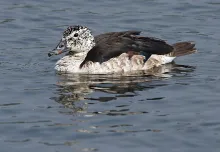
Knob-billed duck (Sarkidiornis melanotis)
Species name
- Dutch name:
- Knobbelpronkeend
- English name:
- African Comb Duck or Knob-billed duck
- German name:
- Höckerglanzgans
- French name:
- Canard à bosse
- Scientific name:
- Sarkidiornis melanotis
Scientific classification
- Order:
- Anseriformes
- Family:
- Anatidae
- Onderfamilie:
- Sarkidiornithidae
- Genus:
- Sarkidiornis
Description
- Description:
Male:
Have blackish upperparts, wing-coverts and secondary flight feathers with green, bluish-purple and bronze gloss. The rump is grey.
The underparts are white, except the greyish flanks and some narrow black bars on breast sides. The undertail-coverts are white, often tinged yellow.
Head and neck are white with black speckles. Crown and nape appear almost black, due to concentration of black spots.
It has prominent, fleshy, blackish knob at base of the upper mandible. The bill is black. The eyes are dark brown. Legs and webbed feet are blackish.
In breeding plumage, the knob is much larger, and the sides of head and neck are washed yellowish-buff.Female:
Is similar but smaller and duller than male, and she lacks the fleshy knob. Her plumage is less glossy.Juvenile:
Is brownish with dark brown crown and upperparts, and scaled underparts.
Standard Measurements
- Body Length (cm):
- The male (drake) of the Knob-billed duck measures approximately 61-76 centimeters. The female measures approximately 61-76 centimeters.
- Body Weight (grams):
- The male will weight about 1770-2270 gram. The female will weight about 1770-2270 gram.
The weight is notoriously variable and can only be used as indication!
- Note:
African Comb Ducks or Knob-billed ducks are generally happier maintained fully-flighted if possible, for example in an aviary for the smaller species, or under flight netting. While the larger species in this group are hardy, the smaller species may be more delicate and require winter shelter.
African Comb Ducks or Knob-billed ducks are generally hardy, but Sarkidiornis melanotos melanotos - Old World comb duck may require shelter in winter. These ducks may bay be aggressive and may require a separate enclosure. These ducks may be difficult to breed but some collections breed them successfully. They may nest in natural vegetation, or use a raised or ground level nest box or a tunnel. Polygamous: maintenance as trios or even with three or four ducks per drake has been suggested.
- Breeding:
- The female Knob-billed duck usually lays from 7-15 yellowish-white eggs and incubates them for 28-31 days.
- Artificial incubating:
The ideal relative humidity for incubating most waterfowl eggs is 55% (ground nesters) and 40% (cavity nesters). The temperature is usually 37.4°C. Set ventilation as recommended by the incubator manufacturer. Eggs must be turned, either automatically or by hand, a minimum of 4 times a day. As the duckling develops there is a loss of water from the egg and the air sac gets bigger. In normal development of an egg with a 28-31 days incubation, the air sac occupies about a third of it three days earlier. Cleanliness is vital and ideally eggs should be moved to a separate hatcher at this point, where the humidity should be increased to 65% and even higher once they have pipped internally.
- Bird banding:
- Recommended closed leg band ring size for the Knob-billed duck is 14♂︎/12♀︎ mm.The leg band ring can only be applied on a young duck at around 14 days old.
- It doesn't matter what leg that you band, but it's good to have a consistent system. Suggested: Left leg = Female, Right leg = Male
- Maintenance food:
-


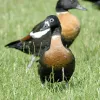


Floating full food for all sea ducks, green ducks, eider ducks and geese, especially in the moulting and breeding phase ideally suited. Packed with wholesome raw materials, natural vitamins and trace elements, this performance food with a protein content of 30% forms the basis for lifelong vitality.


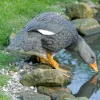
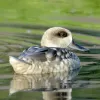
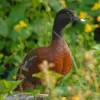


Floatable special complete food for sea birds with the highest nutritional requirements. Each chunk contains the complete nutrient spectrum. The high protein content of 35% ensures a healthy and species-appropriate diet. Spiral algae give a more magnificent coloration of plumage and sea salt promotes the salt gland.


